If you want to know about the introduction of pile foundation or types of concrete and its uses or concrete mix design, please click the link.
Brick masonry is a type of construction that uses bricks as the primary building material. The way in which the bricks are laid in relation to each other is called the bond. The type of bond used can affect the strength and appearance of the structure.
In brickwork, we used many types of bonds to make a wall better in strength as well as in appearance.
1) Types of Bonds in Brick Masonry
Here are the different types of bonds which is using in the brickwork.
- Stretcher Bond
- Header Bond
- English Bond
- Flemish Bond
- Garden-Wall Bond
- Raking Bond
- Dutch Bond
- Brick-On-Edge Bond
- English Cross Bond
- Facing Bond
i) Stretcher Bond
- In the construction of a wall when we arrange all the bricks in such a manner that the only stretcher ( length of brick) is showing then that type of bond is known as stretcher bond.

- Easiest bond to lay & minimizes the amount of cutting required Originally used for single brick walls, now called 1/2 brick walls it became the obvious choice for cavity walls as less cutting was required.
- The main function of the stretcher bond is to provides good bonding between the bricks in wall construction.
- Basically, stretcher bonds are suitable for only one-brick partition walls because the one-brick partition wall does not need any header.
- The stretcher bond is not suitable for the wall which has thicknesses greater than one brick wall because the stretcher bond is not developed a better internal bonding.
ii) Header Bond
- The definition of header bond in civil engineering is, when we arrange all the bricks in header (width) courses then that type of bond is known as header bond in brick masonry or brickwork.
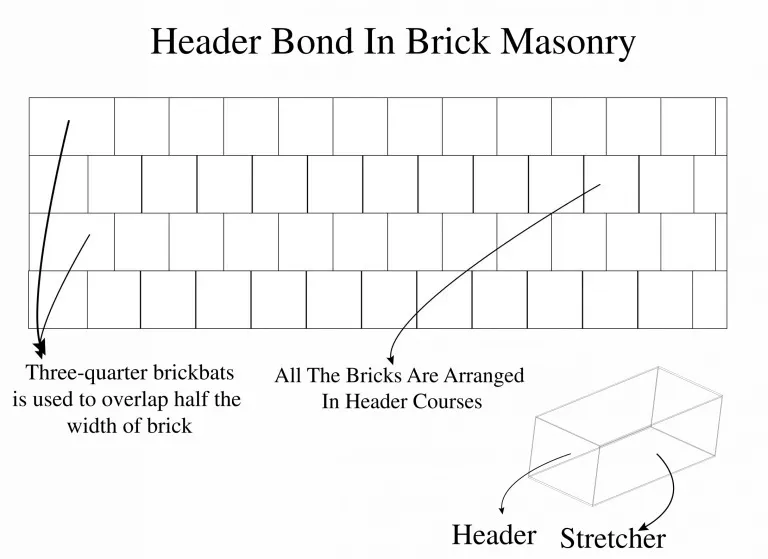
- Header bond in brickwork is suitable for curved surfaces and the construction of walls of full brick thickness.
- The header bonds are not suitable for the load-bearing walls because these types of bonds do not have any strength to transmit the pressure.
- In the header bonding, the overlap is kept equal to half the width of brick and for this, we use three-quarter brickbats in each alternate course.
- The main difference between the header bond and the stretcher bond is, header bonds only contains header courses whereas stretcher bond only contains stretcher courses.
iii) English Bond
- The definition of English bond in brickwork is, when we arrange bricks in such a manner, that one course having header-only and above or below course having stretchers only, is known as English bond.
- The main advantages of using English bond in the construction are, they are the strongest bond in brickwork, that make walls stronger than other bond and it has a pretty good appearance.

- Alternative courses of headers and stretchers; one header placed centrally above each stretcher.
- This is a very strong bond when the wall is 1 brick thick (or thicker).
- One of the strongest brickwork bond patterns.
Features of an English Bond in Brick Masonry

- In the English Bond the courses consist alternate headers and stretchers.
- For developing face lap in English bond, the queen closer is put next to the quoin header.
- Every header is centrally place above or belove the stretcher.
- The joints of bricks in same course are straight.
- In header course, mortar joints are double than stretcher course.
- In English bond the header courses should not start with the queen closer.
- Queen closer is not required in the stretcher courses.
- The stretcher has minimum lap of 1/4th of their length over header.
iv) Flemish Bond
- The definition of Flemish bond in civil engineering is when we arrange the brick in such a manner that header and stretchers are placed alternatively in every course, known as Flemish Bond.

- In Flemish bond, every header is placed centrally over or below the stretcher, and in this type of bond, short vertical joints are formed.
- For the developing the face lap in Flemish bond we have to put the queen closer next to the quoin header in alternate courses.
- Constructing a wall with a Flemish bond required more skill than constructing a wall with an English bond.

- Alternate bricks are placed as header and stretcher in every course. Each header is placed centrally between the stretcher immediately above and below.
- This is not as strong as the English bond at 1 brick thick.
- Can be successfully applied in cavity wall.
Flemish bonds are further divided into two parts
- Single Flemish Bond
- Double Flemish Bond
Single Flemish Bond
- In brick masonry work the single Flemish bond is consists of Flemish Bond and English Bond.
- While using the single Flemish bond for constructing a wall, we combine the strength of the English bond and the appearance of the Flemish bond.
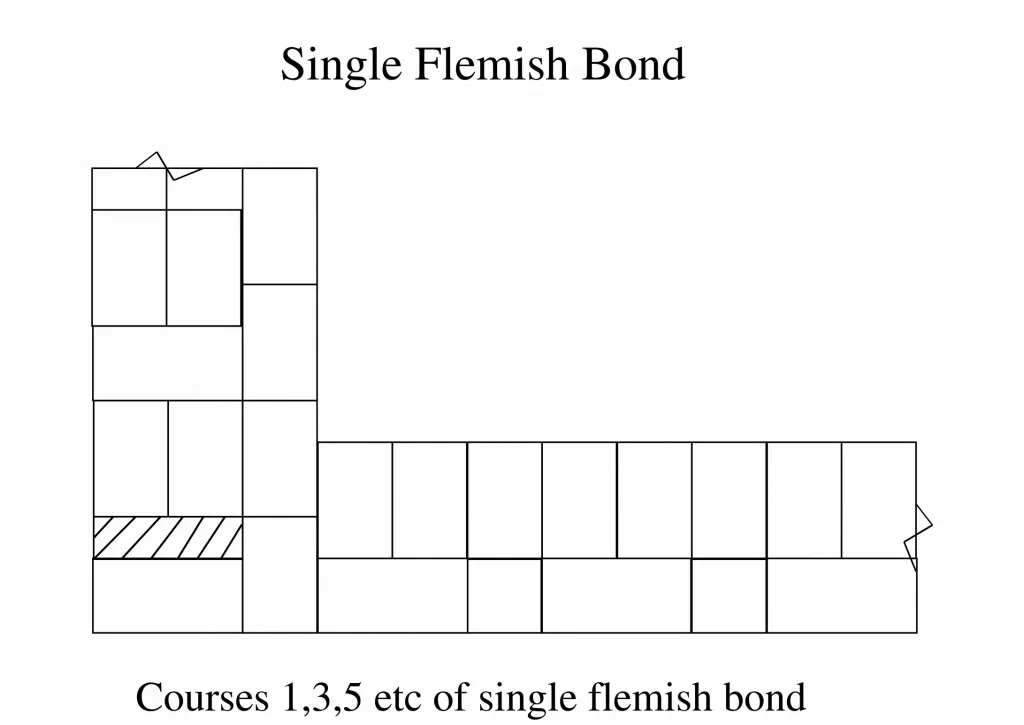
- A single Flemish bond cannot be used for a wall having a thickness of less than 3/2 bricks.
- The single Flemish bond is used when the expensive bricks are used for face work.
Double Flemish Bond
- In the double Flemish bond, the header and stretchers are alternatively placed in every course.
- The double Flemish bond gives a better appearance than the English bond, but it does not stronger than the English bond.
- The double Flemish bond is used, where a better appearance of the wall is required.
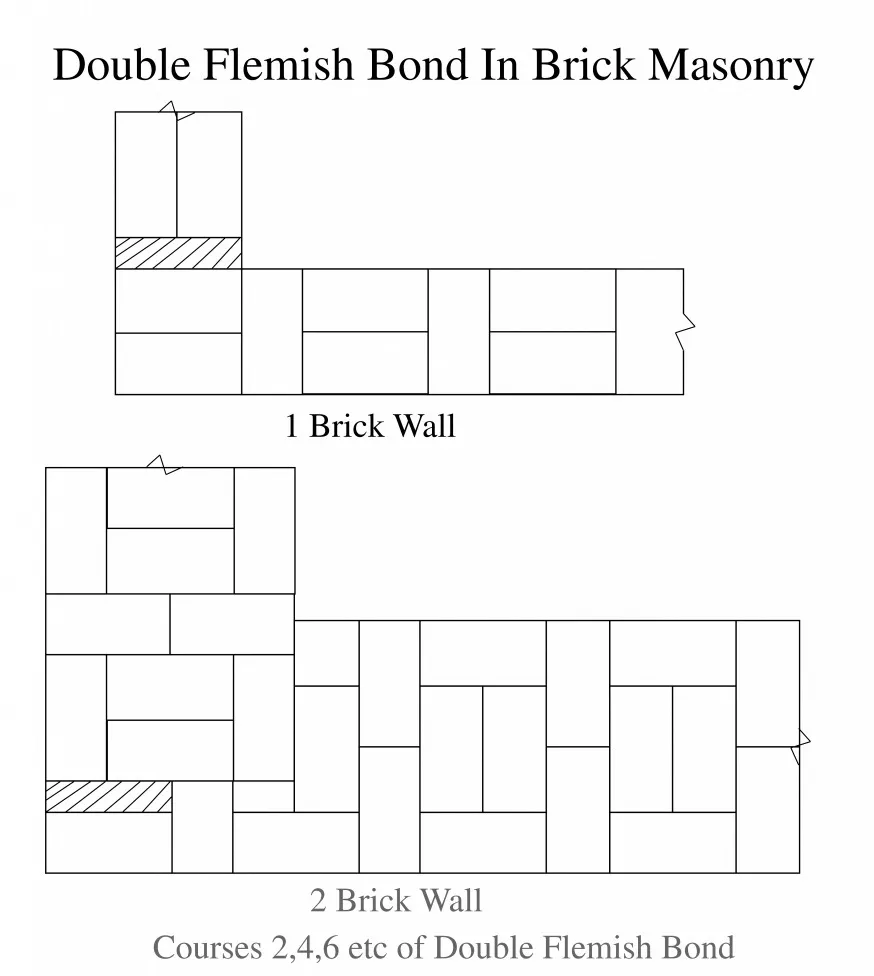
v) Garden-Wall Bond
- The definition of Garden-Wall bond in the brick masonry is, the wall which is one brick wall, and the height of these walls do not greater than two meters.
- The Garden-Wall Bond is used for the construction of the boundary walls, compound walls, garden walls, etc.
The garden wall bond is constructing in two manners:
- English Garden Wall Bond
- Flemish Garden Wall Bond
English Garden Wall Bond
- The definition of English Garden Wall Bond is a wall having one header course after three or five stretcher courses.

- The main difference between the English garden wall bond and the English bond is, English garden wall bond has one header course after 3 or 5 stretcher courses whereas in the English bond alternate courses consist of stretchers and headers.
Flemish Garden Wall Bond
- The Flemish Garden Wall Bond is the wall that contains one header to three or five stretchers in every course.

- Flemish garden wall bond is also known as Scotch Bond or Sussex Bond.
- In the Flemish Garden Wall Bond if each course contains one header to two stretchers, then these types of bonds are known as Monk Bond.
- The main difference between the Flemish Garden wall bond and the Flemish bond is, the Flemish Garden wall bond has one header to three or five stretchers in every course whereas in the Flemish bond in every course, the headers and stretchers are placed alternatively.
vi) Raking Bond
- The definition of the Raking bond in construction is the courses which are inclined is known as raking bond.
- In the raking bond, the inclination in alternate courses should be in opposite directions.
- The raking bond is only provided in the stretcher courses having a thickness equal to the even number of the half brick.
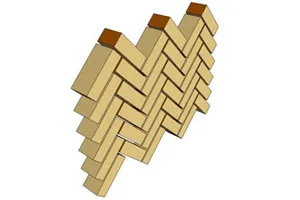
- Herringbone and diagonal bonds can be effective within an exposed framed construction or contained within restraining brick courses.
The Raking bond is further divided into three parts
- Diagonal Bond
- Herring-Bone Bond
- Zig-Zag Bond
Diagonal Bond
- In the diagonal bond wall, the bricks are arranged diagonally and the selection of angle of inclination in such a way that there is a minimum breaking of the bricks.

- The use of diagonal bonds in the construction is for the constructing of the footing of high walls.
- The diagonal bonds are useful for the walls having a thickness of 2 to 4 bricks.
Herring Bone Bond
- The Herring Bone bond is arranged at 45 degrees from the center in both directions.
- In the brickwork, the herring-bone bonds are used for walls having a thickness of more than four bricks and are also useful for making ornamental panels in flooring bricks.

- It is a purely decorative bond.
- It is used in floor and wall panels.
Zig-Zag Bond
- In the Zig-Zag bond, the bricks are arranged in zig-zag manner.
- The zig-zag bonds are useful for making ornamental panels in the flooring of bricks.
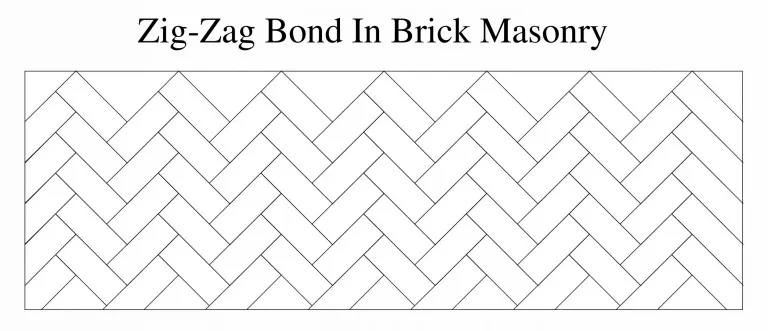
vii) Dutch bond
- Dutch bond in the brick masonry is the modification of the English bond.
- The main use of the Dutch bond is it increases the strength of the wall corner.
- In the Dutch bond, alternatively, courses of header and stretcher are arranged which means one layer of header and one layer of the stretcher are arranged one after another.

viii) Brick On-Edge Bond
- Brick On-Edge bond is a type of brick bond in which the headers and the stretchers are in alternate courses.
- And these headers and stretchers are arranged in such a manner that the header comes at the bed and the stretcher comes at the edge.
- In Brick On-Edge bonds, the bricks are laid on the edge and these types of bonds are economical because it consumes less number of brick and mortar.
- The Brick On-Edge Bond is a weak bond, so it is used to make garden walls, compound walls, partition walls, etc.
- The Brick On-Edge bond is also known as the Silvercock’s bond.
ix) English Cross Bond
- English cross bond is a brick bond in which the headers and stretchers are in alternate courses.
- English cross bond is another modification of English Bond.
- The main use of English cross bond in brick masonry is to increase the beauty of the appearance of the wall.
- The English Cross Bond is also known as the St. Andrews Cross Bond.
- The main difference between the English bond and the English cross bond is, the English cross bond is used for the improvement of the appearance of the wall whereas the English bond is strengthened the brickwork.
x) Facing Bond in Brick
- Facing bond is a type of brick bond in which the header course comes after several stretcher courses.
- In the facing bond, the distribution of load is not uniform because it is not structurally good enough.
2) Rules for Good Bonding in Brickwork
While constructing the wall we should follow the following rule for good bonding.
- In the brickwork the amount of lap should be minimum 1/4 of brick along the length of the wall.
- The amount of lap should 1/2 of brick across the thickness of the wall.
- We should use uniform brick in the brickwork so we can easily get the uniform lap.
- While constructing wall we should put brick in such manner, that vertical joints must along the same perpends.
- The stretchers should be used in the facing.
3) Purposes of Bonding in Brickwork
- The main purpose of bonding in brickwork is to give strength and a good appearance to the wall.
- While constructing any different types of building, if we are not focusing on the bonding between every brick in the brickwork then the wall becomes weaker and collapses at any time.
The choice of bond depends on the design requirements, structural considerations, and aesthetic preferences.
Thanks for well packaged note that can support self study
Thanks alot for good notes
Thanks
Wonderful presentation of notes and the notes are more detailed.